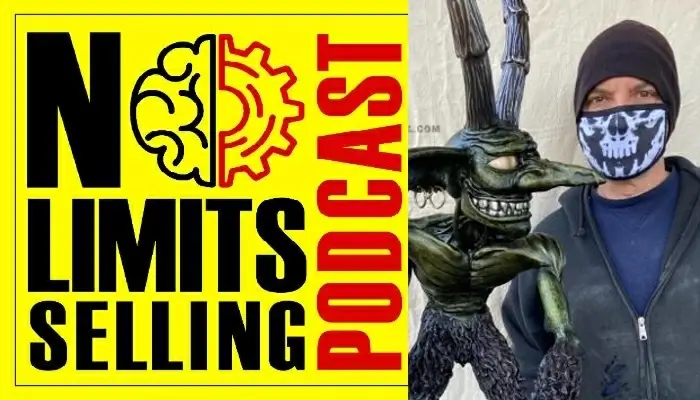The Business Side of Art by Karl Saar
Karl Saar is a sculptor working predominately in steel, aluminum, and bronze. He has been a self-employed sculptor and furniture builder since 1998. Karl says “I don’t really have a cohesive reason for why I make what I make. I believe my subject matter is driven by experimenting with techniques in the shop which leads to an idea. Sometimes a found object, pop culture, or even a client requesting specific criteria in a piece can inform what I produce.”
Podcast Highlights:
- The three faces of art: illusion, delusion, and authentic self
- Stay true to who you are. This is where greatness lives
- Art is all about evoking emotions within others

Contact Karl:
Summary
Introduction
Karl Saar is introduced as the first artist to appear on the podcast. He discusses the challenges of balancing the creative and business aspects of art.
The Business Side of Art
Karl shares his struggles with transitioning from commercial jobs, like creating handrails for the National Aquarium, to focusing more on his passion for sculpture and art. He mentions the challenges of setting up his shop more as an artist than a tradesperson.
Personal Encounters
Umar recalls how he met Karl at a garage sale and bought a unique chair designed by Karl. This leads to a discussion on the subjective nature of beauty and how different people perceive art.
The Artist's Mindset
Karl delves into the self-doubt many artists face, especially when comparing their work to others on platforms like Instagram. He also touches on the challenges of pricing art and the internal battles artists face regarding their self-worth.
The Three Faces of an Individual
Umar introduces a concept where individuals have three faces: the illusion they show to the world, the delusion of who they think they are, and the authentic self. He believes that great art emerges when artists tap into their authentic selves.
Karl's Artistic Journey
Karl agrees with Umar's perspective and shares his journey of trying to create art that resonates with his true self, despite external judgments and self-imposed stigmas.
The Value of Art
The conversation shifts to the commercial aspect of art, where Umar emphasizes the need for artists to separate their creative process from the valuation of their work.
Karl's Background
Karl shares his upbringing in Factoryville, Pennsylvania, a blue-collar town. He speaks about his parents' support for his artistic pursuits, especially his father, who encouraged him to attend art school instead of joining the Marine Corps.
Memorable Sales
Karl recounts a memorable sale from an antique automobile show in Hershey, where a customer deeply connected with one of his pieces, leading to a significant sale.
Breaking Through Limiting Beliefs
Umar discusses the power of understanding the mind and how beliefs from childhood can shape an individual's life. He introduces techniques to identify and overcome limiting beliefs.
Karl's Creative Process
Karl admits that he often faces creative blocks and shares how he overcomes them by sometimes setting projects aside and returning to them later with fresh insights.
The Power of the Heart
Umar guides Karl through an exercise to connect with the spiritual side of his heart, emphasizing the importance of combining both logic and emotion in the creative process.
Conclusion
The podcast concludes with Umar thanking Karl for the insightful conversation, likening it to a therapeutic session.
Questions & Answers
What is the main theme of the "Artist’s Dilemma" podcast episode with Karl Saar?
How does Karl Saar describe the business side of art?
What insights does Umar Hameed provide about the human psyche and art?
How did Karl Saar's upbringing influence his perspective on art and business?
What was Karl Saar's most memorable sale, as discussed in the podcast?
How can artists differentiate between a mere idea and a genuine sense of knowing?
Don’t miss this opportunity to transform your real estate career with one-on-one coaching. As an experienced real estate coach, I, Umar Hameed, am dedicated to helping you unlock your full potential and achieve your real estate goals. To learn more about who am I and my clients ↓
If you’re ready to take the next step, book an appointment with me today and begin your journey toward success in the real estate industry.
